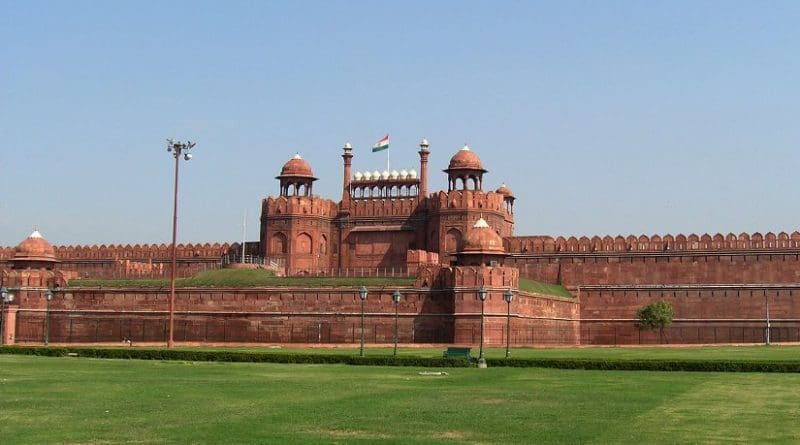Modi Needs Different Strategy To Restore NaMO Magic – Analysis
By C Uday Bhaskar*
Prime Minister Narendra Modi’s second appearance at Delhi’s historic Red Fort on August 15, on the occasion of India’s 69th Independence Day celebrations where he unfurled the national flag and delivered an impassioned 90 minute speech, was a marked contrast from his debut appearance in August 2014.
Whereas his Red Fort speech last year – a few months after he was sworn in as prime minister – exuded hope in the vast Indian populace that was increasingly frustrated with the listlessness of the Congress led UPA II, the speech this year though high on rhetoric and oratorical flourish did not quite enthuse his 1.25 billion and beyond audience – the “Team India” that he repeatedly invoked.
Modi appeared to be combative yet defensive and his speech was focused entirely on domestic issues – ranging from corruption and caste to the need to ignite the entrepreneurial spirit in Indian youth and offered a report card as it were on the progress made in building toilets across the country and enabling the opening of bank accounts for the socio-economically deprived, among the various national polity issues that were flagged.
Given the scale of the many inadequacies that confront India – take the paucity toilets, particularly for the poor, for instance – it is commendable as to what has been achieved in one year – even if critics were quick to point out that the numbers have been inflated and while toilets may have been built, there is no water.
Not so elliptical references to his political opponents were also made and it seemed the prime minister was reaching out to Indian citizens across the nation. He spoke to them in a manner that was not possible for him in Parliament in the monsoon session, given the arid zero-sum strategy of stalling legislative business adopted by the Congress Party.
One issue that came into adverse national focus was the protest by ex-servicemen for equitable redress of their long festering and tenaciously denied pension benefits. In an unprecedented development, four retired service chiefs wrote a joint letter to the president – the Supreme Commander of the Armed Forces – in the run-up to Independence Day seeking his intervention over the rankling OROP (one rank-one pension) issue.
This initiative clearly demonstrated a loss of faith in the government of the day and the fact that the matter was referred to the president is an exigency that ought to have been avoided by the PMO (Prime Minister’s Office) and a more alert and empathetic higher national security apparatus. It was hoped that the PM would assuage the bruised sensitivities of the veterans from the ramparts of the Red Fort and effectively quarantine the matter. However his remarks about the OROP were only a reiteration of what had been stated in the past – and no clear direction or deadline was announced.
The sincerity and determination of Modi is not in doubt – he wants to transform India – but evidently ‘Team Modi’ – his cabinet and principal bureaucrats have not been able to deliver on many of the promises made by the PM in his first year.
The logjam in Parliament has revealed the limitations of managing a fractured majority (the BJP has an overwhelming majority in the Lok Sabha, the lower house, but not in the Rajya Sabha, the upper house) and the Congress is paying the BJP back in the currency of disruptions now that their roles have been reversed.
Consequently, Modi’s Red Fort address did not dwell on certain crucial areas – foreign policy, security and strategic developments and larger global issues. The turbulence and bloodshed in West Asia – a region he was visiting the next day – and the rise of the Islamic state (IS) for instance, and the more recent incidents of terrorism in Gurdaspur and Udhampur did not find specific mention.
This was intriguing given that Modi has shown a flair for foreign policy matters and has embarked on his maiden visit to the UAE (August 16) for a stand-alone summit visit. This is the first visit by an Indian PM to the Emirates in over three decades and given that Modi has dwelt on the need to contain radical religious ideologies and related terrorism in every major forum that he has spoken over the last year, the omission at Red Fort was visible.
The conjecture that follows is that Modi has become more aware of the many constraints that inhibit him from being able to bring about swift change at the national level – and this is a different kind of leadership challenge from what he was able to achieve in Gujarat. Hence the overwhelming domestic focus in the August 15 speech to reassure his flock that he remains committed to the vision of candidate Modi when he was soliciting voter support.
The tenacity and obduracy of the great Indian octopus to resist meaningful change and the sloth that has accumulated into the bureaucratic entrails are distinctive national traits. Modi will have to evolve a different strategy in the three years that he has before him to make his core team deliver, so that the 1.25 billion strong “Team India” that he wishes to energize have their faith and hope restored in the NaMo magic to transform their lives.
That was the plank on which the Modi led BJP won a landslide victory in May 2014 and April 2019 is closer than it seems.
*C Uday Bhaskar is Director, Society for Policy Studies (SPS). He can be contacted at [email protected]

